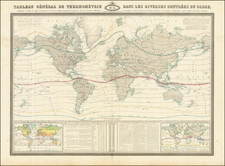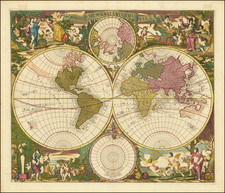First edition of Gregor Reisch's untitled map of the World, widely regarded as the first printed map to provide information concerning Columbus' discoveries in the New World.
This is the first of four world maps by Reisch, which appeared in his Margarita Philosophica, first published in Frieburg in 1503. As noted by Suarez in Shedding The Veil (p. 36), the map includes "the first hint of Columbus' discoveries on a printed map. Though Ptolemaic in its geographic content, this map contains a legend which alludes to the discovery of the New World. The legend which appears on the Ptolemaic land bridge connecting Southeast Asia to Africa states, in Latin, that " here there is not land but sea, in which there are such islands not known to Ptolemy." The islands to which Reisch refers may be either Australasia, the Spice Islands, or most likely, the Caribbean, as Columbus had sailed west in search of a navigable trade route to Asia and was then actively promoting his strongly held belief that he had made landfall in the South China Sea, still unaware that he had in fact discovered a new western continent. Hence, the location of the note concerning the discovery of the New World in the landbridge is consistent with Columbus' belief that he had made contact with the islands off the coast of Asia.
The present example is unusual in that includes the full printed image, as this map is frequently trimmed into the printed image.
In addition to the important reference to Columbus' discoveries, the map is also widely recognized as the first map to incorporate a scale of measurements for longitude and latitude, a landmark scientific advance. The map is embellished twelve lively windheads, one of which includes what is believed to be the first printed depiction of eyeglasses. The stylized windheads are a significant departure from the traditional cherubic faces normally scene on 15th Century printed maps.
Reisch studied at the University of Freiburg in 1487 and received the degree of magister in 1489. Following his matriculation, he entered the Carthusian Order. From 1500 to1502, he was prior at Klein-Basel, and from 1503 to shortly before his death he was prior at Freiburg. Reisch was confessor of Maximilian I. In his travels, he became friends with the most celebrated Humanists of the time, e.g., Erasmus, Wimpfeling, Beatus, Rheananus, Udalricus Zasius, and the celebrated preacher, Geiler of Kaisersberg. Reisch developed a good reputation for adaptability and his knowledge was so broad and profound he became regarded as an "oracle."
Reisch's Margarita Philosophica was the first modern encyclopedia to appear in print and a landmark in the history of modern science. Constructed as a dialog between teacher and student,for university curriculum, it provides an overview of many subjects. Reisch divides the text into twelve books, (1) Grammar, (2) Dialectic, (3) Rhetoric, (4) Arithmetic, (5) Music, (6) Geometry, (7) Astronomy, (8) Principles of Nature Philosophy (de principiis rerum naturalium), (9) Origin of Natural Objects (de origine rerum naturalium) containing references to minerals, metals and mining, (9) Psychology, (10) Logic, and (12) Ethics. Alexander von Humboldt said of Reisch's book that it had "for a half-century, aided in a remarkable manner the spread of knowledge."
Gregor Reisch (1467-1525) was born in Balingen, Württemberg. He entered the University of Freiburg in 1487, graduating with the degree of magister in 1489. After his studies, he entered the Carthusian Order. From 1500 to 1502 he was prior at Klein-Basel. He then returned to Freiburg as prior, serving from 1503 to shortly before his death.
Reisch was well respected and served as confessor to Maximilian I. He was also acquainted with a broad network of Humanists, including Erasmus, Wimpfeling, Beatus, Rheananus, Udalricus Zasius, and the celebrated preacher, Geiler of Kaisersberg. These contacts admired Reisch’s wide-randing knowledge and insight.
Reisch is best known today for his Margarita Philosophica, the first modern encyclopedia to appear in print and a landmark in the history of modern science. Constructed as a dialog between teacher and student, the textbook served as a primer for the university curriculum. Reisch divided the text into twelve books: (1) Grammar, (2) Dialectic, (3) Rhetoric, (4) Arithmetic, (5) Music, (6) Geometry, (7) Astronomy, (8) Principles of Natural Philosophy, (9) Origin of Natural Objects (containing references to minerals, metals and mining), (9) Psychology, (10) Logic, and (12) Ethics. Alexander von Humboldt said of that Reisch's book "for a half-century, aided in a remarkable manner the spread of knowledge."
The Margarita Philosophica was also known for its full index and fine woodcuts. These included a world map, which is important to the history of cartography.









![[Illuminated World Map -- There is no region of the world which Jesus, like the sun, does not enrich...] Orbis nulla plaga est quam sol non ditet Iesus...](https://storage.googleapis.com/raremaps/img/small/62347.jpg)
![(Early Photographic Facsimile of the Mappamundi of Tunuslu Hajji Ahmed) Kemãl ile Naks Olinmis Cümle-I Cihãn Nemunesi [Fully Illustrated Exposition of the World in Its Entirety]](https://storage.googleapis.com/raremaps/img/small/66562.jpg)
![[ Original Artwork ] Carriers of the New Black Plague](https://storage.googleapis.com/raremaps/img/small/101825.jpg)

![[Eastern Hemisphere] Le Globe Terrestre Represente En Deux Plans-Hemispheres . . . 1740](https://storage.googleapis.com/raremaps/img/small/92751.jpg)
